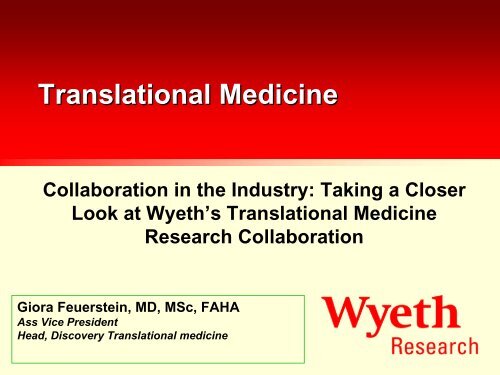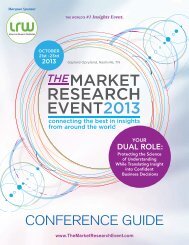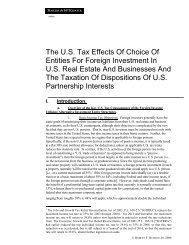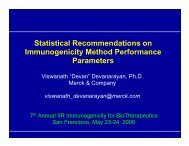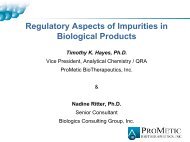Translational Medicine - IIR
Translational Medicine - IIR
Translational Medicine - IIR
You also want an ePaper? Increase the reach of your titles
YUMPU automatically turns print PDFs into web optimized ePapers that Google loves.
<strong>Translational</strong> <strong>Medicine</strong><br />
Collaboration in the Industry: Taking a Closer<br />
Look at Wyeth’s <strong>Translational</strong> <strong>Medicine</strong><br />
Research Collaboration<br />
Giora Feuerstein, MD, MSc, FAHA<br />
Ass Vice President<br />
Head, Discovery <strong>Translational</strong> medicine
Where Have all the New Drugs Gone?<br />
Both the proportion &<br />
absolute number of<br />
compounds that prove<br />
safe & effective<br />
in humans is declining
How are we doing in Drug Development?<br />
Success Rates in All Phases of Drug Development.<br />
Year of Entry into Phase of Drug<br />
Development<br />
Ref: Mervis J. Productivity counts — but<br />
the definition is key. Science 2005;309:726.<br />
Reproduced from JJWood, NEJM 355::6,618,2006
Phase 2 attrition rates are increasing across the<br />
industry<br />
100%<br />
Phase 1 Phase 2 Phase 3 Registration<br />
90%<br />
80%<br />
70%<br />
60%<br />
50%<br />
40%<br />
30%<br />
20%<br />
10%<br />
Lack of efficacy and safety issues are the major<br />
causes of Phase 2 attrition<br />
% failures<br />
33.8<br />
37.6<br />
19.6<br />
9<br />
Both the proportion &<br />
absolute number of<br />
compounds that prove<br />
safe & effective in<br />
humans is declining,<br />
despite an increasing<br />
number that are safe<br />
and effective in animal<br />
models<br />
Economics Efficacy Safety Other<br />
Adapted from: DiMasi, Clin Pharmacol Ther, 2001;69(5):297-307
Industry- Leader in health R&D<br />
JAMA, September 13, 2006—Vol 296, No. 10, 1219
<strong>Translational</strong> <strong>Medicine</strong><br />
<strong>Translational</strong> Research in the<br />
Pharmaceutical Industry<br />
aims at using<br />
Biological Tools for clinical<br />
applications.
<strong>Translational</strong> <strong>Medicine</strong> Mission<br />
Biomarkers<br />
nDiscovery, Validation, implementation<br />
nPK/PD<br />
nEfficacy and MOA<br />
nAdverse effects and MOA<br />
nPatients selection (responders, non-responders, progressors, etc)
Biomarkers: Key strategy to achieve<br />
<strong>Translational</strong> <strong>Medicine</strong> Goals<br />
A “Biomarker” is a quantifiable biological<br />
variable that characterizes cellular,<br />
organ, physiological,<br />
Pathological or clinical condition
Biomarkers: Key strategy to achieve<br />
<strong>Translational</strong> <strong>Medicine</strong> Goals<br />
A “Disease Biomarker” is a biomarker<br />
that maintains significant correlation<br />
with a physiological,<br />
Pathological or clinical condition
Be Ware of Biomarkers Correlations<br />
CRP AND OTHER MARKERS OF INFLAMMATION IN THE PREDICTION OF CARDIOVASCULAR DISEASE IN WOMEN<br />
. P RIDKER, H. HENNEKENS, J E BURING, N RIFAI. NEJM 2000; 342, 836
Biomarkers: Key strategy to achieve<br />
<strong>Translational</strong> <strong>Medicine</strong> Goals<br />
“Target-Compound Interaction” Biomarker:<br />
a biomarker<br />
that denotes direct interaction of<br />
compound with its designated target.
Biomarkers: Key strategy to achieve<br />
<strong>Translational</strong> <strong>Medicine</strong> Goals<br />
A “Pharmacodynamic Biomarker”<br />
is a<br />
biomarker that characterizes<br />
the pharmacological consequence(s) of<br />
drug interaction with a biological target
Biomarkers: Key strategy to achieve<br />
<strong>Translational</strong> <strong>Medicine</strong> Goals<br />
Surrogate Biomarker: The Most Desired Biomarker<br />
Biomarker that substitute for (predicts)<br />
clinically meaningful endpoints<br />
(clinical endpoints directly measure how patients function, feel or survive)
Biomarkers: Key strategy to achieve<br />
<strong>Translational</strong> <strong>Medicine</strong> Goals<br />
“Biomarker for Patients selection” is a<br />
biomarker that characterizes certain<br />
patients that are likely to respond or<br />
resist treatment
So how can the most promising drug candidates<br />
be identified earlier in development?<br />
Target/<br />
Disease<br />
Animal models do not accurately<br />
predict the effects of drugs in man!<br />
<strong>Translational</strong> <strong>Medicine</strong><br />
Information<br />
Technologies<br />
for integration<br />
Discover and develop<br />
biomarkers to objectively measure<br />
drug effects in man<br />
Animal<br />
Biomarker<br />
Fingerprint<br />
Platforms:<br />
“omics”<br />
Chemical biology<br />
Immunoassays<br />
Imaging<br />
Human<br />
Biomarker<br />
Fingerprint<br />
Better predict clinical safety and<br />
efficacy of drug candidates<br />
Better understanding of animal<br />
model relative to human disease
company or university has<br />
access to more than 1% of<br />
No single pharmaceutical<br />
global R&D talent<br />
Academic/industrial collaborations are<br />
important for the success of TMed<br />
NATURE REVIEWS | DRUG DISCOVERY VOLUME 4 | OCTOBER 2005<br />
N Engl J Med 353;15 October 13, 2005
At Wyeth we favor collaborations where<br />
goals, risk and reward are shared<br />
A common current model…<br />
The new model…<br />
No strings attached funding<br />
High risk, “blue skies” projects<br />
Endowments<br />
And increasingly…<br />
Pay to “access” university network<br />
Unrealistic IP positions<br />
Focus on disease mechanisms<br />
Shared goals and objectives<br />
Complimentary skill base<br />
Jointly funded by academia and<br />
industry<br />
Shared risks and rewards<br />
True “collaboration”
Each party brings a particular set of strengths to<br />
the partnership<br />
New therapeutics<br />
Product development<br />
Clinical trials<br />
Technology applications<br />
Focus and drive<br />
+<br />
World-class research<br />
University networks<br />
New technology<br />
Tissue banks<br />
Educational programs<br />
+<br />
Stable population<br />
Single health provider<br />
Unique patient identifier<br />
Patient registries<br />
Data networks<br />
IP & know-how<br />
IP & know-how<br />
IP & know-how<br />
Umbrella agreement for shared and protected IP
Success from the partnership is anticipated in<br />
many forms<br />
Research…<br />
Identification of novel biomarkers<br />
New animal and human<br />
experimental models<br />
A better understanding of human<br />
biology and disease<br />
Generation of peer–reviewed<br />
publications<br />
Increased funding opportunities<br />
Commercial…<br />
Shared collection of ideas & IP<br />
Economic growth in the life<br />
sciences industry<br />
New diagnostic tools<br />
Increased number of novel<br />
therapies<br />
Healthcare…<br />
Earlier diagnosis of disease<br />
Better medicines for patients
The TMRC is a 5 year renewable commitment by<br />
Scottish Enterprise & Wyeth<br />
Scottish Enterprise<br />
Commitment<br />
Operational: $35 million<br />
over 5 yrs<br />
Wyeth Commitment<br />
Operational : $8.5 million<br />
Research contracts: ~$45<br />
million over 5 yrs<br />
TMRC<br />
A dedicated research institute<br />
devoted to translation science<br />
and biomarker development<br />
Hub for translational community<br />
Educational and scientific leadership<br />
High quality preclinical and clinical<br />
research<br />
New biomarkers and experimental<br />
models<br />
New diagnostic tools for patient care
Research apportioned to the Universities and the Core<br />
Laboratory based unique strengths<br />
TMRC<br />
“Centers of Excellence”<br />
Aberdeen<br />
Edinburgh<br />
Dundee<br />
Glasgow<br />
Imaging & physiology<br />
Experimental models<br />
Patient populations<br />
Operational Center<br />
Leadership and Governance<br />
Core<br />
Research<br />
Laboratory<br />
Core<br />
Clinical<br />
Laboratory<br />
Research<br />
Operations<br />
Molecular biomarkers:<br />
Discovery, development<br />
and validation
Wyeth has formed a unique partnership between<br />
4 universities and the Scottish government<br />
Why Scotland?<br />
• World-class basic & clinical<br />
research<br />
• World-class technology<br />
• Patient base<br />
• Data networks<br />
• Umbrella agreement<br />
• Government support
TMRC in the media<br />
NATIONAL NEWS<br />
Drugs group to fund research network.<br />
By ANDREW BOLGER and ANDREW JACK<br />
4 April 2006<br />
Wyeth, the US drugs group, yesterday signed a Pounds 50m deal with Scottish<br />
Enterprise and four leading academic institutions to create a pioneering<br />
medical research network.<br />
The universities of Dundee, Edinburgh, Aberdeen and Glasgow and National<br />
Health Service Scotland will link in a "translational medicine"<br />
collaboration with Wyeth designed to identify new ways to treat patients<br />
with heart disease, cancer, depression and osteoporosis.<br />
The research will focus on the identification of "biomarkers".


